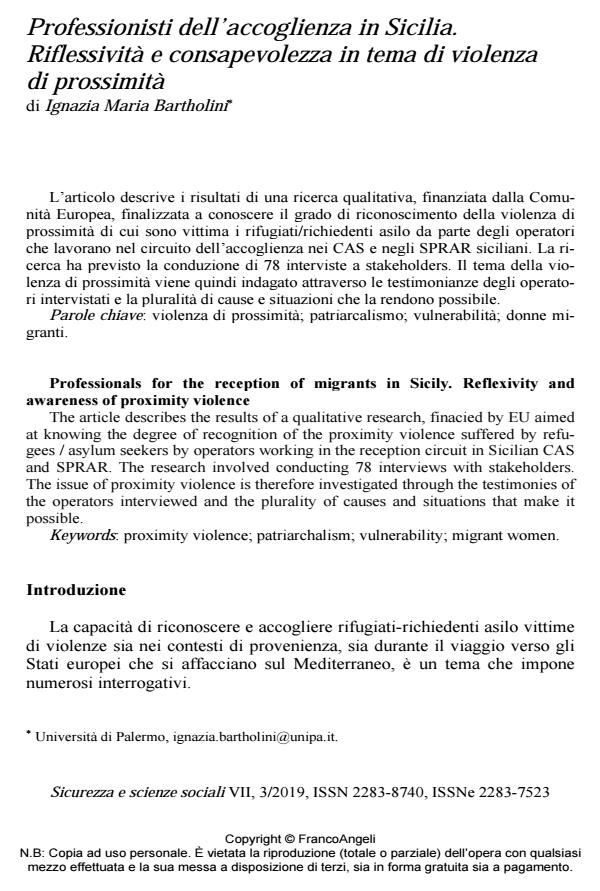Professionals for the reception of migrants in Sicily. Reflexivity and awareness of proximity violence
Journal title SICUREZZA E SCIENZE SOCIALI
Author/s Ignazia Maria Bartholini
Publishing Year 2020 Issue 2019/3 Language Italian
Pages 16 P. 111-126 File size 202 KB
DOI 10.3280/SISS2019-003008
DOI is like a bar code for intellectual property: to have more infomation
click here
Below, you can see the article first page
If you want to buy this article in PDF format, you can do it, following the instructions to buy download credits

FrancoAngeli is member of Publishers International Linking Association, Inc (PILA), a not-for-profit association which run the CrossRef service enabling links to and from online scholarly content.
The article describes the results of a qualitative research, finacied by EU aimed at knowing the degree of recognition of the proximity violence suffered by refu-gees / asylum seekers by operators working in the reception circuit in Sicilian CAS and SPRAR. The research involved conducting 78 interviews with stakeholders. The issue of proximity violence is therefore investigated through the testimonies of the operators interviewed and the plurality of causes and situations that make it possible.
Keywords: Proximity violence; patriarchalism; vulnerability; migrant women.
- Bartholini I.M. (2013). Violenza di prossimità. La vittima, il carnefice, lo spettatore e il “grande occhio”. Milano: FrancoAngeli.
- Bartholini I.M. (ed.) (2014). Violenza di genere e percorsi mediterranei. Milano: Guerini e Associati.
- Bartholini I.M. (ed.) (2019). Proximity violence in migration times. Milano: FrancoAngeli.
- Bracke S. (2016). Bouncing back: Vulnerability and Resistance in Times of Resilience. In: Butler J., Gambetti Z., Sabsay L. (eds.) (2016).
- Butler J. (2004). Undoing Gender. Abignton: Routledge
- Butler J., Gambetti Z., Sabsay L. (eds.) (2016). Vulnerability in resistance. London: Duke University Press.
- Charmaz K. (2014). Constructing Grounded Theory. United Kingdom: Sage Publication.
- Deriu F. (2016). Violenza di genere, capacitazione, resilienza ed empowerment: verso un nuovo framework interpretativo. Autonomie locali, n. 3: 2001-2009.
- Ferrarotti F. (1981). Storia e storie di vita. Bari: Laterza.
- Granovetter M. (1983). The Strength of Weak Ties: A Network Theory Revisited. Sociological Theory, Vol. 1: 201-233.
- IOM (2017). Migrant Vulnerability to Human Trafficking and Exploitation: Evidence from the Central and Eastern Mediterranean Migration Routes. Geneva.
- Kirby P. (2006). Vulnerability and Violence: the Impact of Globalization. London: Pluto Press.
- Nussbaum M.C. (2012). Creare capacità, liberarsi dalla dittatura del Pil. Bologna: il Mulino.
- Ortensi L.E. (2019). L’immigrazione in Europa. In: Ventiquattresimo Rapporto sulle migrazioni 2018. Milano: FrancoAngeli.
- Peano I. (2013). Opaque Loves: Governance and Escape in the Intimate Sphere of Nigerian Sex Workers. Etnografia e ricerca qualitativa, 3: 359-84.
- Pinelli B. (2011). Attraversando il Mediterraneo. Il sistema campo in Italia: violenza e soggettività nelle esperienze delle donne. Lares, 77: 159-180.
- Rutter M. (2012). Resilience as a Dynamic Concept. Development and Psycho-pathology, 24: 335-344 ( DOI: 10.1017/S0954579412000028)
Ignazia Maria Bartholini, Professionisti dell’accoglienza in Sicilia. Riflessività e consapevolezza in tema di violenza di prossimità in "SICUREZZA E SCIENZE SOCIALI" 3/2019, pp 111-126, DOI: 10.3280/SISS2019-003008